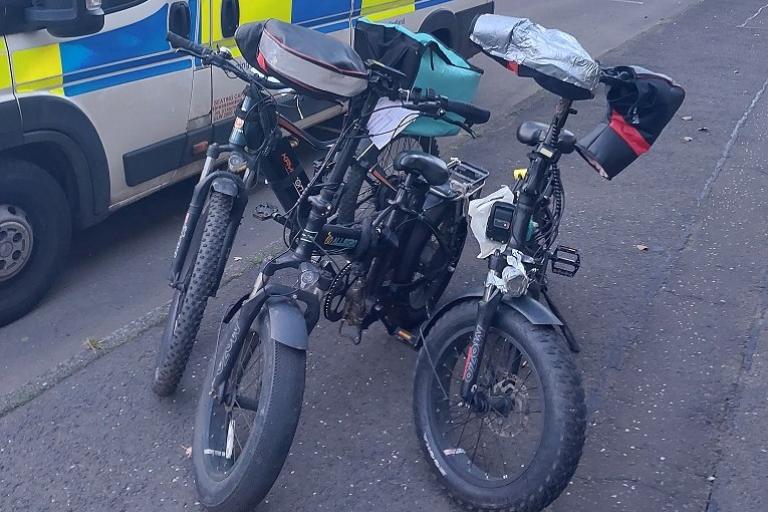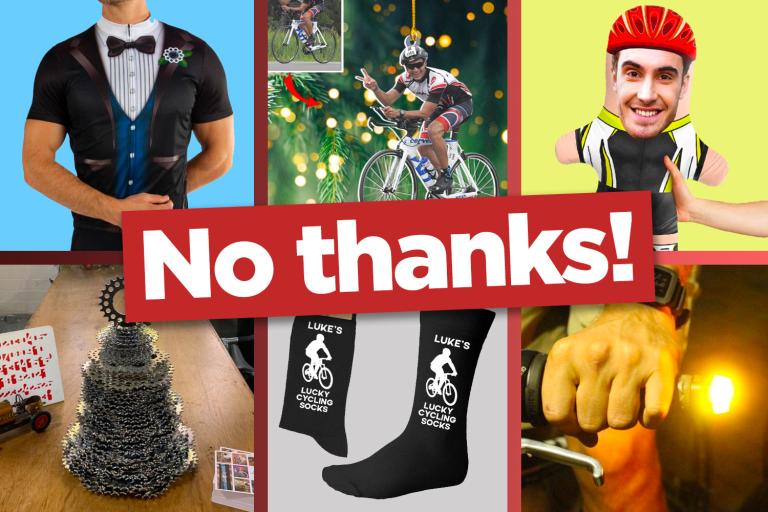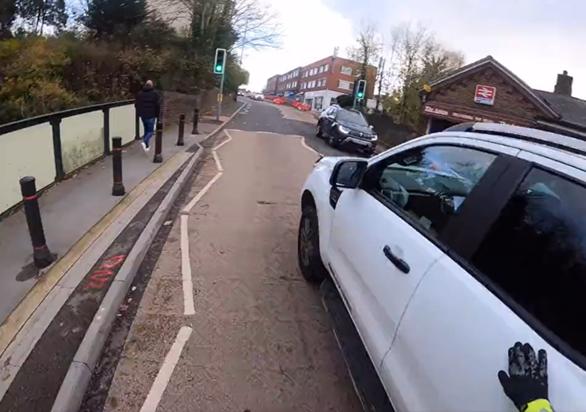- News
- Reviews
- Bikes
- Accessories
- Accessories - misc
- Computer mounts
- Bags
- Bar ends
- Bike bags & cases
- Bottle cages
- Bottles
- Cameras
- Car racks
- Child seats
- Computers
- Glasses
- GPS units
- Helmets
- Lights - front
- Lights - rear
- Lights - sets
- Locks
- Mirrors
- Mudguards
- Racks
- Pumps & CO2 inflators
- Puncture kits
- Reflectives
- Smart watches
- Stands and racks
- Trailers
- Clothing
- Components
- Bar tape & grips
- Bottom brackets
- Brake & gear cables
- Brake & STI levers
- Brake pads & spares
- Brakes
- Cassettes & freewheels
- Chains
- Chainsets & chainrings
- Derailleurs - front
- Derailleurs - rear
- Forks
- Gear levers & shifters
- Groupsets
- Handlebars & extensions
- Headsets
- Hubs
- Inner tubes
- Pedals
- Quick releases & skewers
- Saddles
- Seatposts
- Stems
- Wheels
- Tyres
- Health, fitness and nutrition
- Tools and workshop
- Miscellaneous
- Tubeless valves
- Buyers Guides
- Features
- Forum
- Recommends
- Podcast
news
“Poor thing has already lost a hand”: Selfridges joins the “don’t ride it like that” Christmas list of dodgy bike displays; Halfords slammed (again) for “victim-blaming” hi-vis “naughty list”; Pro cyclists do gymnastics (kind of) + more on the live blog
SUMMARY
 Selfridges back-to-front bike display (Cargo Bike Ben, Twitter)
Selfridges back-to-front bike display (Cargo Bike Ben, Twitter)19 December 2023, 09:08

“Poor thing has already lost a hand”: Selfridges joins the “don’t ride it like that” Christmas list of dodgy bike displays
I sense a pattern developing throughout the nation’s Christmas bicycle displays, and it’s one that could possibly lead to quite the number of cuts and bruises come the big day.
Last week, you may recall, Halfords – the UK’s ‘largest bike shop’, remember – treated us all to some festive merriment with this dubiously arranged mountain bike, tactfully described by one observer as “all the right parts, just not necessarily in the right places”:
And today, we’re climbing a few rungs on the social ladder (watch you don’t get a nosebleed) and heading to Selfridges, where cyclist Ben spotted this back-to-front masterpiece which he believes is a surefire contender for our upcoming “don’t ride it like that” end-of-year awards…
Oh Selfridges… 😂
Definitely another one for the “don’t ride it like that” books.@roadcc @Francis_Cade @jimmidnicholls @gcntweet pic.twitter.com/ePodNmudjX
— Cargo Bike Ben (@cargobikeben) December 18, 2023
“The basket,” Michael replied in the comments, presumably with his head in his hands as he typed. “The front wheel is facing backwards and the basket is on the side of the rider actually.”
I’m sure that’ll be a fun Christmas morning ride for the kid – or perhaps Selfridges is breaking new ground with their basket placement, like when they started putting bottle cages on downtubes in the middle of the last century?
Maybe we’ll all look back in 50 years’ time and think, ‘ah, remember when baskets used to be placed in front of your handlebars? Those crazy early 2020s!’
Or maybe not.
“And that’s before you even look at the brake,” Ben added.
“Yep, poor thing has already lost a hand,” wrote Paul, noting the dangers of such questionable display set-ups even for the unfortunate mannequins. But at least they’re wearing a helmet, I suppose (ducks for cover in the comments section).
With only six days to go until Christmas, let’s see if Selfridges’ back-to-front display can be topped before Santa comes. And let’s hope the elves have a touch more experience when it comes to setting up bikes…
19 December 2023, 11:37
“Victim blaming of the highest order”: Halfords slammed (again) for hi-vis cyclist “naughty list” post
Hmmm… Along with questionable display bike set-ups, Halfords seems to be making a habit lately of posting inflammatory winter social media posts about cyclists.
Last year, the UK’s largest retailer of cycling products and services decided to weigh in on the whole bike helmet debate, for some reason (surely not to sell helmets?), by advising cyclists that they “strongly recommend” wearing one… just in case a tree branch falls on your head.
And just last month, Halfords’ social media admin decided to post on Facebook (that bastion of sensible, reasoned debate) an ambiguous graphic depicting a cyclist and a motorist on the road, along with the not-at-all-provocative question: “Who has right of way?” – prompting, rather inevitably, an avalanche of anti-cycling bingo replies in the comments.
And now, the retailer’s Christmas intern has decided to keep the hate ball rolling by posting a short list of “people who deserve to be on the naughty list”.
How festive.
To be fair to the admin, two of the three “naughty” road users listed are motorists (as Meat Loaf once said, that ain’t bad), scolded for refusing to indicate and for ignoring warning lights on their dashboard.
However, while the post itself encouraged a whole host of comments calling on Halfords and their allegedly shoddy service to be placed on the list (see how these things can backfire?), one particular naughty list member – “cyclists who don’t wear high vis at night” – provoked yet another round of Halfords “victim blaming” allegations.
“No. 2 is victim blaming of the highest order. Why can’t drivers just pay attention and look where they are going and not at their phones?” wrote Steve.
“I can’t believe that Halfords are victim shaming cyclists,” added Joseph. “No. 1: Is technically driving without due care and attention. No. 2: Cyclists generally have lights and it is the responsibility of the car/trucks to ensure they are driving properly. No. 3: Agree this is very dangerous to drive with warning lights on.
“Not sure who approved this post but I’d have a word with them!”
> "Wear a helmet!" Halfords advises... because a tree branch might fall on your head
Meanwhile, the anti-cycling bingo brigade was also out in force.
“Cyclists who don’t have lights on their bikes should be top of the list!! Along with cyclists who don’t wear helmets,” said Liz, ticking off two in one go.
I know, social media engagement, blah, blah, but surely there’s a better way to promote your shops than pitting your two main customers against each other? Surely? At least just for Christmas?
19 December 2023, 12:48

“Cyclists are causing chaos for drivers”: Glasgow Times claims pensioner is “too scared to leave home due to cyclists” – despite the man himself singling out delivery riders – while son argues cycle lanes are a “danger to pedestrians”
So, where does a regular commuter or leisure cyclist end and a delivery rider on an illegally modified e-bike begin?
Well, that’s the question posed by a recent edition of the Glasgow Times, which featured a front page story with the headline ‘Glasgow man left scared to leave home due to cyclists on pavements’ – despite the pensioner in question singling out speeding food delivery cyclists on “very big” bikes as one of the primary reasons for his concern.
A bit of a stretch there…
“I think there are more bikes around in the area now because of people doing deliveries and they are not all using the roads,” 84-year-old Mohammed Ishaq, from Anderston, told the local paper.
“They also go too fast and annoy people. I don’t think some of those riding bikes care about their own safety or anyone else’s. Some of the bikes look very big and can be quite scary.”
However, the pensioner also claimed that road layout changes to accommodate active travel have made leaving the house “confusing”.
“There are too many barriers when going out like works going on and rubbish everywhere and people cycling on pavements,” he said.
“It’s very hard now to walk around the area safely. Even crossing the roads is strange with some roads divided into separate areas for cycling which is confusing.”
> Cyclists warned city's new e-bike ban will be "clamping down on any cases of reckless behaviour"
While Mr Ishaq focused on delivery cyclists and bike lane layouts, his son, however, was much more forthright in his criticism of people on bikes in general, claiming that those who cycle responsibly are in the “minority” and that the rest are “causing chaos” for drivers and pedestrians.
“The cycle lanes are a danger to pedestrians crossing the road because they don’t understand the layout of the cycle lanes and the fact is a lot of cyclists are not stopping when it’s a red light,” Dr Abid Ishaq told the Glasgow Times.
“There are also cyclists going through red lights even when there’s no cycle lane and basically endangering themselves and causing chaos for drivers.
“We live in a country where we should be able to walk about freely in a safe environment and there are elderly and disabled people who are finding it difficult.
“They have to walk across a pavement, and they don’t know if they’re going to get hit by a cyclist. It makes me really sad, really angry, not just with the behaviour of cyclists but also with the failure of law enforcement agencies and the council to acknowledge the problem and put measures in place to tackle it.”
> Council calms critics' concerns contraflow cycling could cause confusion and chaos
Despite the newspaper’s ambiguous headline, Police Scotland’s road policing inspector Hugh Niccolls appeared to indicate that those using illegal e-bikes or e-scooters formed the bulk of the problems encountered by Mr Ishaq.
“We have been carrying out joint patrols with officers from the local Problem Solving team in Glasgow city centre in response to complaints and incidents relating to e-bikes and e-scooters that are not road legal,” Niccolls said.
“Our focus is on educating riders on safety and legislative requirements, as well as using enforcement action where necessary. Road safety remains a priority and I would encourage anyone with information or concerns about potentially illegal e-bike or e-scooter activity to speak to officers on patrol in Glasgow City Centre or call Police Scotland on 101.”
Meanwhile, a Glasgow City Council spokesperson added: “We are fully committed to improving the city’s environment for active travel, whether that be walking, wheeling, or cycling.
“Pedestrians are recognised as the most vulnerable road users and we are working on a wide range of initiatives that will make travel on foot as safe as possible.
“Concerns over safety are also the single biggest barrier to people cycling and this why we are currently delivering a significant expansion of the city network of cycling infrastructure. When safer, segregated cycle ways are introduced the number of people cycling along these routes has been shown to increase significantly.
“Before a cycle way can be formally opened for use, the new infrastructure will be subjected to an independent safety audit that considers the safety of all road users.
“All road users are expected to follow the Highway Code at all times to ensure the safety of themselves and others. Where rules are breached, such as cycling through a red light, cycling on the pavement, or riding an unlicensed e-motor bike, enforcement is a matter for the police.”
While the Glasgow Times appears keen to lump e-bike using delivery riders in with every other cyclist in the city, last month we reported that Glasgow’s police responded to safety concerns from cyclists and a cycling charity about food delivery couriers riding illegal e-bikes dangerously, with the crackdown coming in the same week a cyclist said he had been left “terrified” by a crash caused by an incident which saw him hit in a cycle lane by a courier riding the wrong way at high speed.
Officers from Police Scotland seized 15 illegal e-bikes and reported more than 20 people for road traffic offences, with pictures shared by the force on social media showing high-powered or modified illegal e-bikes that can assist the rider beyond the 15.5mph (25km/h) e-bike limit and are legally distinct from the Electrically Assisted Pedal Cycles (EAPC) requirements.
Police Scotland said it was “targeting those riding illegally modified electric bikes capable of going at high speeds”, the comments coming in the same week Cycling Scotland had called on food delivery companies to provide couriers “effective training around cycling safety” and check the bikes they ride “are legal and road worthy”.
So, not so quick next time to present cyclists as a homogenously dangerous block, eh Glasgow Times?
19 December 2023, 16:30

Glasgow cycling charity launches Young Bike Mechanic Programme
Bike for Good, Glasgow’s largest cycling charity and social enterprise, has this week launched its new Young Bike Mechanic Programme, which aims to transform opportunities for young people in the city, providing them with accredited non-formal learning opportunities and creating employment pathways within the cycling industry.
Funded by Gannochy Trust and the UK Government Levelling Up Fund, the programme aims to train 32 young people aged between 14 and 21, who will undergo an eight-week volunteering experience before advancing to a two-day Cytech Technical 1 training and assessment programme, enabling them to pursue a career in bike mechanics.
“Bike for Good is proud to introduce the ‘Young Mechanic’ programme, a groundbreaking initiative that harnesses the power of hands-on learning and community engagement to empower young individuals and foster sustainable employment pathways within the cycling industry,” Gregory Kinsman-Chauvet, CEO and Founder of Bike for Good, said in a statement.
“This programme embodies our commitment to fostering a diverse and skilled workforce, while simultaneously contributing to a greener and more equitable future.”
Applications are now open, and anyone looking to apply is asked to contact glasgow [at] bikeforgood.org.uk.
19 December 2023, 15:58

Cycling UK welcomes “significant boost” in active travel funding in Scotland – despite budget falling short of promised amount at beginning of parliament
Cycling UK has welcomed the “significant boost” in active travel funding announced as part of today’s Scottish Budget statement, as finance secretary Shona Robison pledged £220m of funding for cycling, walking, and wheeling schemes in 2024/25, an increase of £31m on the previous year.
However, the charity did note that the new active travel budget still falls “disappointingly short” of the £320m promised for the coming year at the beginning of the current parliament in 2021 under the Bute House Agreement, a confidence and supply pact signed by the SNP and Greens as they entered government together.
Nevertheless, Cycling UK argues that today’s “record investment” emphasises that Scotland is still leading the way when it comes to active travel in the UK.
> Scottish Government urged to spend more on public transport and less on cycling
“At a time of considerable strain on the public purse, the Scottish Government’s Budget provides a welcome and significant boost in funding for projects that will enable people to make local journeys by cycling, walking, or wheeling,” Cycling UK’s campaigns and policy manager for Scotland, Jim Densham, said this afternoon.
“£220m is a record investment that shows Scotland is leading the way within the UK, although it falls disappointingly short of the £320m promised at the beginning of this Parliament. We urge the government to ensure that this target is met in 2025/26.
“Investing in active travel is proven to be excellent value for money: every £1 spent on cycling and walking schemes provides almost £6 worth of benefits, including improved health and wellbeing, reduced congestion and better air quality.
“The continued growth in funding gives councils across Scotland the opportunity to enable more people to cycle easily, confidently and safely."
19 December 2023, 15:42
Speeding driver who accelerated to 71mph seconds before killing 14-year-old girl using cycle path jailed for four years and 10 months
A speeding driver who killed a 14-year-old girl cycling on a shared-use path when he overtook another vehicle and accelerated to 71mph, seconds before oversteering and mounting the raised kerb, has been jailed for four years and ten months.
The 22-year-old had been driving southbound on Oakington Road, speeding to a nearby pub to play pool, Cambridge Crown Court hearing that he had been travelling “at speed” just moments before mounting the raised kerb and fatally injuring the teenager who was cycling northbound along the shared-use cycle path that runs next to the road.
19 December 2023, 15:07

SweetSpot co-founders Hugh Roberts and Mick Bennett, organisers of the modern Tour of Britain and the Women’s Tour, set to retire
At the end of what has been a tumultuous, stressful, and occasionally exhilarating year for cycle racing in the UK, two of the pioneers of the domestic scene’s revival and prolonged success over the past two decades, SweetSpot founder Hugh Roberts and race director Mick Bennett, are set to retire, the group confirmed today.
Roberts and Bennett founded SweetSpot, going onto establish the modern iteration of the Tour of Britain in 2004, ushering in arguably the national stage race’s most successful ever period. They also created the annual Tour series of crit races throughout the UK, while their organisation credits include the road events at this year’s UCI cycling world championships in Scotland and, along with London Marathon Events, the RideLondon Olympic legacy event.
Perhaps most significantly, Roberts and Bennett founded the Women’s Tour in 2014, moulding the stage race into one of the most exciting and well-organised women’s events on the calendar.
However, the cancellation of this year’s Women’s Tour and the Tour series – amidst an increasingly challenging period for race organisers beset by economic, logistical, and sponsorship troubles – coupled with complaints from fans about the character of races that did go ahead, such as the Tour of Britain, ensured that 2023 was an especially challenging year for SweetSpot.
In a statement announcing Bennett and Roberts’ retirement, which follows the departure earlier this year of SweetSpot’s PR and press director Nick Bull, the organisation said: “Having enjoyed an unbroken run of annual events – Tour of Britain, Women’s Tour and Tour Series – from 2004, the effects of the pandemic severely disrupted the 2020 and 2021 calendars and SweetSpot’s business model.
“In 2022 the death of Her Majesty Queen Elizabeth II during the fifth stage brought an abrupt end to the Tour of Britain, and the enforced cancellation of the final three stages of the race, while the combination of inflationary pressures, the cost of living crisis, and local government funding issues have presented increased challenges to events in 2023.
“Over the past 20 years the free-to-attend Tours delivered by Hugh, Mick, and the SweetSpot team, have been watched at the roadside and on free to air ITV by millions of spectators and viewers, providing a source of inspiration for the countless school children lining the routes and taking part in support activities, and provided a platform for British riders to race against the world’s best on home roads.”
19 December 2023, 14:29

Why don’t cyclists use the cycle paths? Errr… Because there’s a hunt taking place on it
Yes, really. Over the years, we’ve heard plenty of reasons why riding on a dedicated cycleway may not be the best plan of action, occasionally, for the cyclist seeking to get from A to B – including everything from potholes, terrible layouts, and badly deteriorated surfaces to parked cars, floods, mud, and acts of sabotage.
> Why don't cyclists use cycle lanes?
But I don’t think I’ve ever seen a cycle path completely blocked by a group of horse-riding eighteenth-century nostalgists and their poor dogs, as they cling to their grim, dying, and banned tradition of hunting foxes for sport (and you thought the EPO era of pro cycling was bad).
But that’s what took place in South Nottinghamshire yesterday, as a group of hunt saboteurs followed the toffs and their horses through some damp fields and onto National Cycle Route 64, where apparently they were “hemmed in by landfill sites and the gypsum works before heading back to their lorries and calling it a day”.
Who knows, maybe the hunters will have been seduced by the allure of the cycle path, ultimately giving up their antiquated ‘sport’ and getting a bike instead? We can only dream…
19 December 2023, 14:59
Just another day on Channel 5
Midday Moan: Should we ban cyclists?
Broadcaster @AliMirajUK calls for a crackdown on bikes.
What do you think?#StormHuntley
— Jeremy Vine On 5 (@JeremyVineOn5) December 18, 2023
Cue the road tax and cycling number plates and insurance comments (sigh)…
Meanwhile, next up on ‘chance encounters that definitely did not happen’ is this creative taxi driver and his imaginary passenger:
Just had a tfl bod onboard..nice chat..whether “True or Not”apparantley next year or next all cyclists in London will have to be “registered” with a number on the helmet or hi vis..
— markiboy (@gotpowerdp) December 18, 2023
It’s the most wonderful time of the year…
19 December 2023, 13:22
Study finds drivers who cycle or understand recommended cyclist road positioning are less likely to blame bicycle riders for close passes
A newly published study has examined how drivers view close passes on cyclists, with researchers looking into the effect of cycling experience, knowledge of recommended cyclist road positioning, and a driver’s tendency to express anger behind the wheel on the way an individual perceives close pass incidents.
The paper, conducted by academics in Anglia Ruskin University and published in next month’s Transportation Research Part F: Traffic Psychology and Behaviour journal, examined the responses from a sample of 239 UK drivers when shown eight video clips of close pass incidents submitted by cyclists as driving complaints to Essex Police in 2020.
And it found that drivers who were not cyclists apportioned greater liability to cyclists seen being close passed in the video footage.
Furthermore, participants whose ‘vehicleDAX’ score (rating the tendency to use vehicle manoeuvres to express anger when driving, such as punishment passes) was on the high end of the scale were less likely to agree that the close passes shown were dangerous. Colour me shocked…
19 December 2023, 12:12

World sprint champion Emma Finucane wins 2023 BBC Cymru Wales Sports Personality of the Year
It’s been quite the year for rising track star Emma Finucane, who followed up her four national titles and two European silvers with a maiden rainbow jersey in the sprint at the world championships in Glasgow in August, dominating throughout the competition before beating Lea Sophie Friedrich with two blistering rides to claim the world title.
And now the 20-year-old from Carmarthen, who also took silver as part of the British team sprint squad at the Glasgow worlds, has been recognised at home for her breakthrough year, winning the BBC Cymru Wales Sports Personality of the Year, following in the wheel tracks of former cycling winners Geraint Thomas (2018 and 2014) and Nicole Cooke (2003).
“It’s amazing, there are so many legends that have won this [award],” Finucane told the BBC after being presented with her accolade.
“I really appreciate that people have appreciated what I’ve done. It’s nice to have a nation behind me, supporting me. We are quite a small country but to have that passion behind us and to have them on my sleeve as well is really important.”
With Finucane’s trophy cabinet slowly starting to fill as she establishes herself as one of the fastest women in the world, there may be a few more accolades coming her way in 2024.
19 December 2023, 11:12

It’s time for a road.cc classic: The cycling-themed presents you should definitely NOT buy the cyclist in your life for Christmas
There are a few things that are just classic Christmas staples, sure to get you in the festive mood as late December rapidly approaches – Brussels sprouts, garish lights outside your neighbour’s home, bickering with a distant relative about politics.
Oh, and VecchioJo’s annual road.cc list of gifts you really shouldn’t buy the cyclist in your life (because trust us, they don’t want them).
New and updated for 2023, while featuring some greatest hits – from the bike-shaped pizza cutter to comedy kits and THAT weird defecating chain dog (I don’t know either) – here’s Jo’s list of cycling-themed presents that really are better left on the shelf or in the online shopping basket…
> All I want for Christmas is... not this. Gifts not to buy for cyclists to avoid a festive faux pas
19 December 2023, 10:37

Adieu, GCN+
Well, that’s it, the end of an (admittedly brief) era of unprecedented pro cycling streaming coverage, as GCN+ shuts its doors today, a blank, desolate screen where hundreds of colourful bike races used to be.
(Okay, maybe I’m being a touch over-sentimental, but it’s an emotional day…)
Anyway, here’s a brief glimpse into how everyone is dealing with the live cycling platform’s demise, and our collective headlong plunge back to 2015:
Just deleted GCN+ from the tv… just so sad! Thank you for being my friend over the past few years especially through Covid @daniellloyd1 @si_richardson and all the other @gcntweet presenters thank you. Shame on you @wbpictures
— Donald Young (@SlapshotJC) December 19, 2023
How I'm feeling about the closure of GCN+ pic.twitter.com/1uOGx1R1NV
— Burd (@tonywilson01) December 17, 2023
Trawling through the Discovery Plus webshite to try and find what cross they will be showing... pic.twitter.com/1mFbVfGPdh
— Simon Warren (@100Climbs) December 18, 2023
And, for those of you still unsure about your future cycling viewing options, today would be a good day to check out our handy guide for life after GCN+:
> What’s the best way to watch live cycling following the closure of GCN+?
19 December 2023, 10:03
How to give your team boss a heart attack in one not-so-easy somersault
Looks like SD Worx, fresh from a team building ski trip to Italy, are enjoying the start of pre-season proper, at least judging by ace sprinter Lorena Wiebes’ attempt to channel her inner gymnast by somersaulting from the top of some rickety old beach football goalposts…
SD Worx team boss be like 🫣
📸 Demi Vollering Instagram pic.twitter.com/FGEWgv6n33
— Dan Deakins (@DanDeakins) December 19, 2023
“There is always a bit of a gymnast in me,” the three-time Tour de France Femmes stage winner commented on teammate Demi Vollering’s Instagram video of her daredevil stunt.
(Well, I say ‘daredevil’, but we are talking about cyclists after all. Wiebes’ fellow Dutch rider Joop Zoetemelk couldn’t even complete one pull-up when he appeared on Superstars after winning his 1980 Tour title. So the bar isn’t really that high, pardon the pun.)
However, I’m not sure sports directors Danny Stam and Anna van der Breggen will be too delighted to see their star sprinter wobbling precariously on a set of goalposts during a training camp.
Though, to be fair, Stam isn’t necessarily known for his own aversion to risky, potentially dangerous behaviour, especially when he’s behind the wheel of a team car – so you may get off with just a warning, Lorena…
After obtaining a PhD, lecturing, and hosting a history podcast at Queen’s University Belfast, Ryan joined road.cc in December 2021 and since then has kept the site’s readers and listeners informed and enthralled (well at least occasionally) on news, the live blog, and the road.cc Podcast. After boarding a wrong bus at the world championships and ruining a good pair of jeans at the cyclocross, he now serves as road.cc’s senior news writer. Before his foray into cycling journalism, he wallowed in the equally pitiless world of academia, where he wrote a book about Victorian politics and droned on about cycling and bikes to classes of bored students (while taking every chance he could get to talk about cycling in print or on the radio). He can be found riding his bike very slowly around the narrow, scenic country lanes of Co. Down.
Latest Comments
- espressodan 2 sec ago
No they don't. WBD chose to pay for the rights and pay what they paid. WBD choose the resources to allocate to coverage. ...
- RoubaixCube 1 hour 43 min ago
That rear blinker looks a little like the RAVEMEN CL06 with a few changes. WOuldnt surprise me if they were made by the same company in the same...
- Dnnnnnn 5 hours 55 min ago
Tend to agree with Rendel - while I'm sure well-intended, it's an ill-judged post.
- lio 6 hours 13 min ago
Well Soudal do sell their products in the UK too. It's what I buy in B&Q because it's the only brand I've heard off and that's from cycling.
- Rendel Harris 6 hours 29 min ago
Terrible story and genuine sympathy for the lady, and I realise this could easily look like victim blaming, but I'm 6 foot tall, male and built...
- bruxist 6 hours 36 min ago
I really wasn't convinced by the inferences in this particular study. I'm certainly convinced by others, but this one seems to miss the most...
- ktache 6 hours 45 min ago
Lost his licence for dui, again?...
- David9694 7 hours 5 min ago
Welcome to Car Crashes into Building.
- chrisonabike 7 hours 13 min ago
Cases of hung, drawn and caught? Or if not in favour of the rules, hung, drawn and court erred?
- chrisonabike 7 hours 27 min ago
I think that's fair. Just noting that as you've written that you can see that it's incredibly hard to get away from any narrative of "we need at...






Add new comment
28 comments
The defence lawyer has already got charges of death from dangerous driving thrown out for this one. Their claims of tragic accident makes interesting reading.
https://www.hulldailymail.co.uk/news/hull-east-yorkshire-news/defence-wo...
I'm not sure interesting is the correct word, I need to go and calm down after reading it. It's just infuriating. I hope roadcc will follow up on this up even though no cyclists were involved. If I've understood what happened correctly and the driver gets away with it we are all in deep trouble.
That the driver of the car that caused the collision is a "young girl" should be irrelevant.
She is clearly over 18 - and as such is a woman and not a "girl".
And if she is that "young", then why was she allowed to drive such a lethal peice of machinery in the first place?
I am not an expert, but having driven vehicles ranging from small cars to 75ft articulated lorries, aquaplaning is caused by driving inappropriately to the weather conditions... which should be either Careless, Reckless or Dangerous driving.
https://www.rac.co.uk/drive/advice/winter-driving/understanding-aquaplan....
Age and gender are irrelevant and are only being used as a sympathy ploy
The defence barrister sums up nicely why Magistrates, judges and juries go easy on drivers in court: "There but for the grace of God go I. There but for the grace of God go us all."
Look Mum no hands! When you've cocked up so badly one hand isn't enough to say sorry.
Today's numpty behind the wheel, I thought I'd check the camera footage as there was an alarming scrubbing of tyres behind me as I pulled into a gap between parked cars to allow an oncoming supermarket delivery van past. This driver had emerged from a side road, without checking it was clear and I think was attempting to overtake me before immediately turning left.
I should add they were being profusely apologetic to the oncoming van driver. I doubt it even crossed their mind what the cyclist was thinking on hearing a car roaring up behind then screeching to a halt.
A novel way to start introducing your riders for 2024? https://www.instagram.com/p/C1BrQL9uZoS/
*Full disclosure, I created this
"Study finds drivers who cycle or understand recommended cyclist road positioning are less likely to blame bicycle riders for close passes"
Entitled drivists who don't cycle don't know anything in the HC that's cycling related? Who knew?
"Bloody cyclist shouldn't be doing the thing the HC tells them they should be doing".
There should be a full cycling section on the Driving Theory test.
I see you're still not including any mention of the petition startd by Ishaq Son that failed miserably before he found out that weaponising your Dad would get you better press coverage
https://www.change.org/p/remove-dangerous-and-underused-cycle-lanes-in-g...
...oh and this one. https://www.bbc.co.uk/news/uk-england-leeds-67758665
Thought I'd share this story. https://www.bbc.co.uk/news/uk-england-cambridgeshire-67754731
Highway Code Rule 60
At night your cycle MUST have white front and red rear lights lit. It MUST also be fitted with a red rear reflector (and amber pedal reflectors, if manufactured after 1/10/85). White front reflectors and spoke reflectors will also help you to be seen. Flashing lights are permitted but it is recommended that cyclists who are riding in areas without street lighting use a steady front lamp.
There's no requirement or even a recommendation to wear high-viz at night in the highway code. Reflectors are probably more effective than lights, and don't run out of power. Halfords might consider checking the appropriate guidance and laws before posting about road 'safety'.
Reflectors aren't more effective as they require a light source to shine on them whereas a light can been seen from various angles with no light source. How much light is reflected back compared with the lumens output of a front light ?
Hmm... depends on *your* light also.
I've got dynamo-driven lights on all my regular rides so I never forget the lights or run out of charge. They're certainly bright enough both to see by and to be seen (if someone's looking - which is the key part...) However ...
...reflective materials can be pretty salient particularly when on the spokes or your limbs as they can be moving. Yes everything's moving but sometimes your bike lights might be on a constant bearing / decreasing range relative to a driver and thus not so noticable.
Reflectors can also have a large area compared to bike lights.
If someone's driving about without lights I'd say you're already in an "all bets are off" situation - at best that signals "driver with low awareness".
So I hope for the day when this becomes increasingly moot* but would continue to recommend reflective bits as part of a balanced "looking like a Christmas tree" "help the poor motorist and myself" strategy.
* To avoid an arms race where everyone is competing with ever brighter lights / reflective / phosphorescent clothing (like a Baskerville hound) and yet not more visible over everyone else's lights and glitter. Meanwhile the urban environment at night gives everyone migranes.
Reflective spoke straws are a cheapish, lightweight addition. And from my view of others, work very well.
Agreed - certainly expensive straws, but cheap "doing something"... Quieter than spokey dokeys too! Not up for the "flashing lights on wheels" jobs, they're cute but a little wasteful I think.
Also - cheap(ish) stick on reflective tape, think I've got a lifetime's supply (a roll). From 3M IIRC?
Outside of the direct beam, from the side or a rear angle? Quite a lot I'd say. When the battery expires? Even more.
Not really an evidential statement though. When the battery expires, I have other lights- you don't really go out with just one front and rear light surely ?
Reflectors don't really do much when a light source is not in the immediate 3d vicinity of other road users. Street lamps, and other vehicle's head lamps will not be reflected or concentrated towards anyone.
So, if a car's dipped beam headlights are off or not working, or if a cyclist is approaching from the side or rear of a vehicle, reflectors will give no aid to visibility at all.
Flourescent clothing is "charged" by UV lights however specifically in the case of yellow its brightness still emits long after darkness falls. It is just easier to detect as in low light conditions it reflects or emits more detectable photons than its surroundings - and is not a natural colour. It does still, however , require other road users to be observant.
Fluorescent material (as used in hi-viz) fluoresces under UV light, which is to say it absorbs UV and reradiates the energy at a different (visible) wavelength, hence it appears unnaturally bright. But the effect is instantaneous, it does not charge up like a watch face. Your hi-viz jacket does not continue to glow in the dark.
Rule 59 says "reflective clothing and/or accessories (belt, arm or ankle bands) can increase your visibility in the dark".
If you've got good lights I'm not sure it really makes any difference though.
"If" doing the work. Batteries fail, lights break, lights are not so effective side on. I've no problem with taking good advice.
That is the definition of a recommendation, not a requirement.
Any HC rules that are backed up by law will use the word MUST in them. I don't see this word anywhere in rule 59.
The hi-viz obsession in the UK is hilarious.
Doesn't hi-iz require the presence of natural UV light (stuff that tends to be absent at night) to be effective? Not sure how wearing hi-viz at night achieves much other than pandering to one of the angry motoring lobby's strawmen.
I was out for a night ride last night (working lights front & rear and reflectives on both me and the bike before you ask) & I'd add some other stuff to their list:
1 Drivers who refuse to dip their full beams / think that 20 metres away from me = "pretty much past" so just flip them back on
2 Drivers who have only discovered how to switch their sidelights on and drive around at night with them on
3 other cyclists who are a) drafting fairies and b) whose lights are angled straight at your face when you shoulder check
Merry Winterval
2) seems to be increasing, not sure if it's because driving lights are much brighter, the autolight thing is faulty or people are really that clueless.
Couldn't believe the other night, how badly people were driving on unlit country roads and close passing me, and i had lights and reflectors, even a bright yellow jacket, don't know if the dark made it a worse experience but its put me off riding at night for a bit on those roads.
Not a driver, do modern cars have automatic dipping lights?
Back in the day, running one or two specialized 2.5s, often was high beamed, when I properly upgraded to my Night Sun Tri-Light, mainly running the 12W flood middle, those that refused to dip for quite a good light would instantly dip if I used the remote to flick on the 20W spot.
Today it's the Tap on the helmet activating my Exposure Axis.
Auto dipping is typically an optional extra. I've had it on hire cars, but I'm not a fan. Sometimes it dips late, other times it dips for a reflective road sign. Usually it works OK.
My night rides are usually MTB with a very short road section. I have an offensively bright front lamp, so on the road I will step the brightness down.
Yep, modern cars have auto dipping high beam lights. They do actually work quite well.
There's also more complicated laser matrix lights, which let you have full beam on all the time, they just dim the bit around the car ahead. But when it comes to pedestrians in the road, the light system shines a brighter beam at the pedestrian. Better than not seeing them I guess!
https://youtu.be/xe66enKPLHk?feature=shared&t=34
That's why hi-viz jackets combine fluro material and retro-reflective material. Fluro does its thing under daylight, retro does its thing under headlamps.